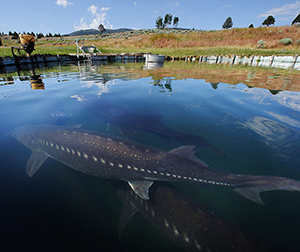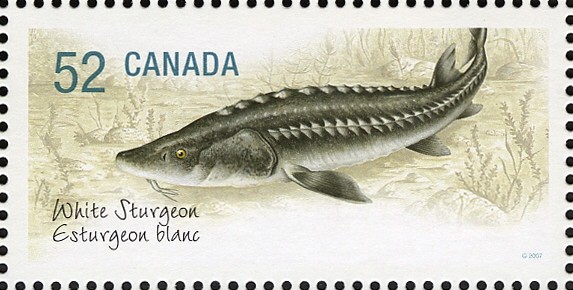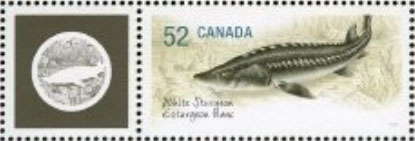Acipenser transmontanus Richardson, 1836

(Da: www.flickr.com)
Phylum: Chordata Haeckel, 1874
Subphylum: Vertebrata Lamarck J-B., 1801
Classe: Actinopterygii Klein, 1885
Ordine: Acipenseriformes Berg L.S., 1940
Famiglia: Acipenseridae Bonaparte, 1832
Genere: Acipenser Linnaeus, 1758
Italiano: Storione bianco, Storione americano
English: White Sturgeon, Pacific sturgeon, Oregon sturgeon, Columbia sturgeon, Sacramento sturgeon, California white sturgeon
Français: Esturgeon blanc
Deutsch: Weißer Stör
Descrizione
Simile agli altri storioni, si distingue per il numero dei raggi delle pinne e dalle caratteristiche degli scudi ossei cutanei. Il colore è grigio brunastro con ventre bianco e pinne grigie. Può raggiungere i 610 cm di lunghezza e vivere fino a 104 anni. Gli esemplari anandromi possono pesare fino a 682 kg, mentre quelli esclusivamente di acqua dolce non raggiungono dimensioni così elevate. Gli adulti catturano prevalentemente pesci (spinarelli, lamprede, altri storioni) e anfibi, i giovani insetti (Tricotteri, Chironomidi, Efemerotteri), crostacei (anfipodi, gamberetti, copepodi) ed altri invertebrati come molluschi. Si riproduce nei fiumi, e ritorna al mare dopo la deposizione. Tende a scegliere zone con corrente non troppo forte e fondali sabbiosi per riprodursi. Le principali minacce alla sua esistenza sono dovute all'attività umana sui fiumi, che rende difficoltoso ai pesci raggiungere i siti riproduttivi e alla pesca. La specie è comunque classificata come "a rischio minimo" (LC) dalla lista rossa IUCN.
Diffusione
È endemico delle coste pacifiche del Nord America tra l'Alaska e la Baja California. È stato introdotto in molti altri stati degli USA ed in Europa, Italia compresa, dove però non si sa se si riproduca spontaneamente. È una specie anadroma che vive in mare e penetra nei fiumi solo per la riproduzione ma si conoscono anche popolazioni che passano tutta la loro vita nei fiumi.
Bibliografia
–Duke, S. (U.S. Fish & Wildlife Service), Down, T., Ptolemy, J., Hammond, J. & Spence, C. (Ministry of Water, Land & Air Protection, Canada) (2004). "Acipenser transmontanus". IUCN Red List of Threatened Species. 2004.
–[Acipenser transmontanus summary page. (n.d.). Retrieved October 04, 2017.
–Hildebrand, L. R.; Drauch Schreier, A.; Lepla, K.; McAdam, S. O.; McLellan, J.; Parsley, M. J.; Paragamian, V. L.; Young, S.P. (2016). "Status of White Sturgeon (Acipenser transmontanus Richardson, 1863) throughout the species range, threats to survival, and prognosis for the future". Journal of Applied Ichthyology. 32: 261-312.
–Dingerkus, G; Howell, W. (1976-11-19). "Karyotypic analysis and evidence of tetraploidy in the North American paddlefish, Polyodon spathula". Science. 194 (4267): 842-844.
–Drauch Schreier, A.; Gille, D.; Mahardja, B.; May, B. (2011). "Neutral markers confirm the octoploid origin and reveal spontaneous autopolyploidy in white sturgeon, Acipenser transmontanus". Journal of Applied Ichthyology. 27: 24-33.
–[Kohlhorst, D. W.; Botsford, L. W.; Brennan, J. S.; Caillet, G. M. (1991): Aspects of the structure and dynamics of an exploited central California population of White Sturgeon (Acipenser transmontanus). In: Acipenser. Actes du premier colloque international sur l’esturgeon. P. Williot (Ed.). CEMAGREF, Bordeaux, France, pp. 277-293. 518 pp.
–Robichaud, David; English, Karl K.; Nelson, Troy C. (2017). "Annual Movements of Acoustic-Tagged White Sturgeon in the Lower Reaches of the Fraser River and its Tributaries". Transactions of the American Fisheries Society. 146 (4): 611-625.
–Parsley, Michael J.; Popoff, Nicholas D.; Wright, Corey D.; van der Leeuw, Bjorn K. (July 2008). "Seasonal and Diel Movements of White Sturgeon in the Lower Columbia River". Transactions of the American Fisheries Society. 137 (4): 1007-1017.
–[Muir, W. D., McCabe, G. J., Parsley, M. J., & Hinton, S. A. (2000). Diet of first-feeding larval and young-of-the-year White Sturgeon in the lower Columbia river. Northwest Science, 74(1), 25-33].
–Crossman, James A.; Jay, Kathleen J.; Hildebrand, Larry R. (2016). "Describing the Diet of Juvenile White Sturgeon in the Upper Columbia River Canada with Lethal and Nonlethal Methods". North American Journal of Fisheries Management. 36 (2): 421-432.
–Gawlicka, A.; Herold, M. A.; Barrows, F. T.; de la Noue, J.; Hung, S. S. O. (2002). "Effects of dietary lipids on growth, fatty acid composition, intestinal absorption and hepatic storage in white sturgeon (Acipenser transmontanus R.) larvae". Journal of Applied Ichthyology. 18 (4-6): 673-681.
–Chapman, F. A., Van Eenennaam, J. P., and Doroshov, S. I. "The reproductive condition of white sturgeon, Acipenser transmontanus, in San Francisco Bay, California". Fishery Bulletin. 94: 628-634.
–Marineau, Mathieu D.; Wright, Scott A.; Whealdon-Haught, Daniel R.; Kinzel, Paul J. (2017). "Physical characteristics of the lower San Joaquin River, California, in relation to white sturgeon spawning habitat, 2011-14". Scientific Investigations Report.
–Coutant, Charles C. (2004). "A Riparian Habitat Hypothesis for Successful Reproduction of White Sturgeon". Reviews in Fisheries Science. 12: 23-73.
– [Israel, J., Drauch, A., Gingras, M. (2009). Life history conceptual model for white sturgeon. Unpubl. technical report to Bay Delta Ecosystem Restoration and Improvement Program, Sacramento, CA, USA, 54 pp.]

|
Data: 01/10/2007
Emissione: Specie minacciate di estinzione Stato: Canada Nota: Emesso in una serie di 4 v. diversi con appendice e senza e in un foglietto di 4 v. diversi senza appendice al francobollo e in un foglietto di 4 v. diversi con appendice al francobollo |
|---|

|
Data: 01/10/2007
Emissione: Specie minacciate di estinzione Stato: Canada Nota: Emesso in una serie di 4 v. diversi con appendice e senza e in un foglietto di 4 v. diversi senza appendice al francobollo e in un foglietto di 4 v. diversi con appendice al francobollo |
|---|